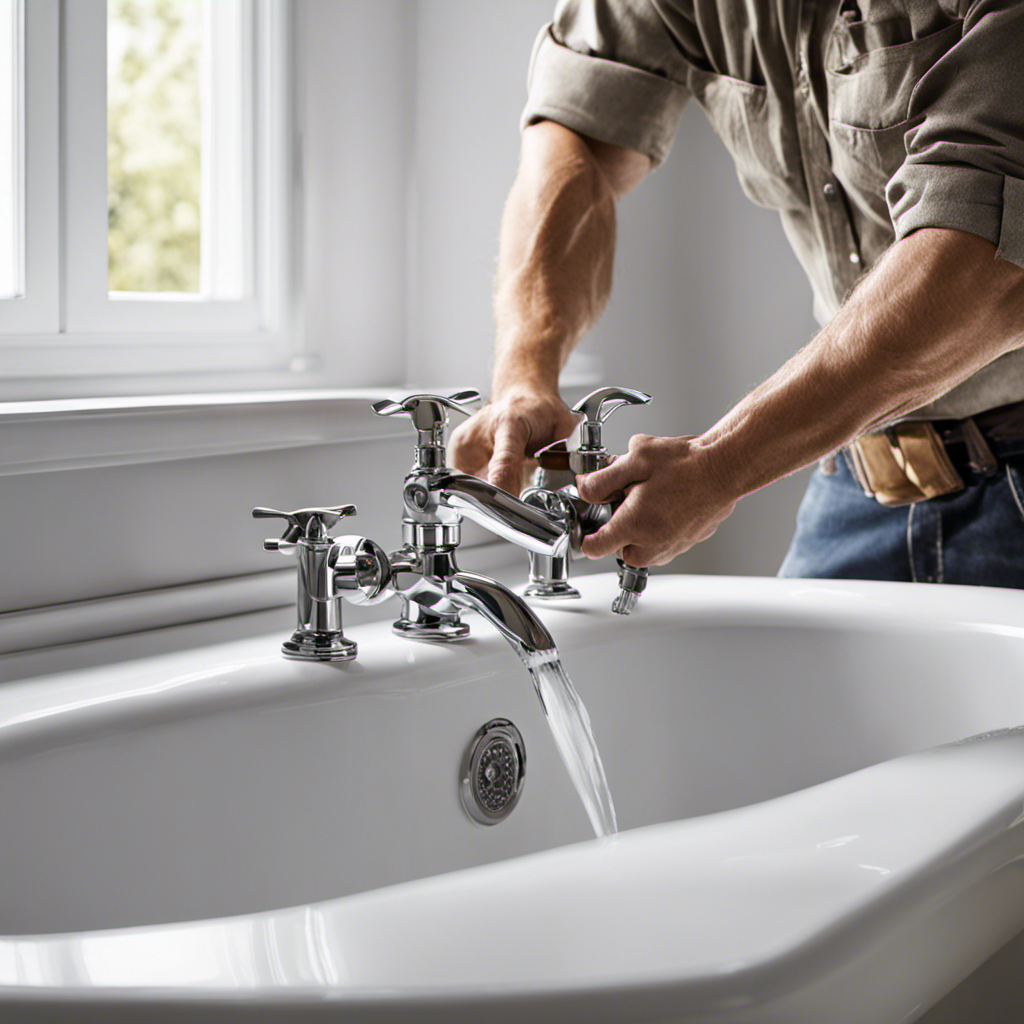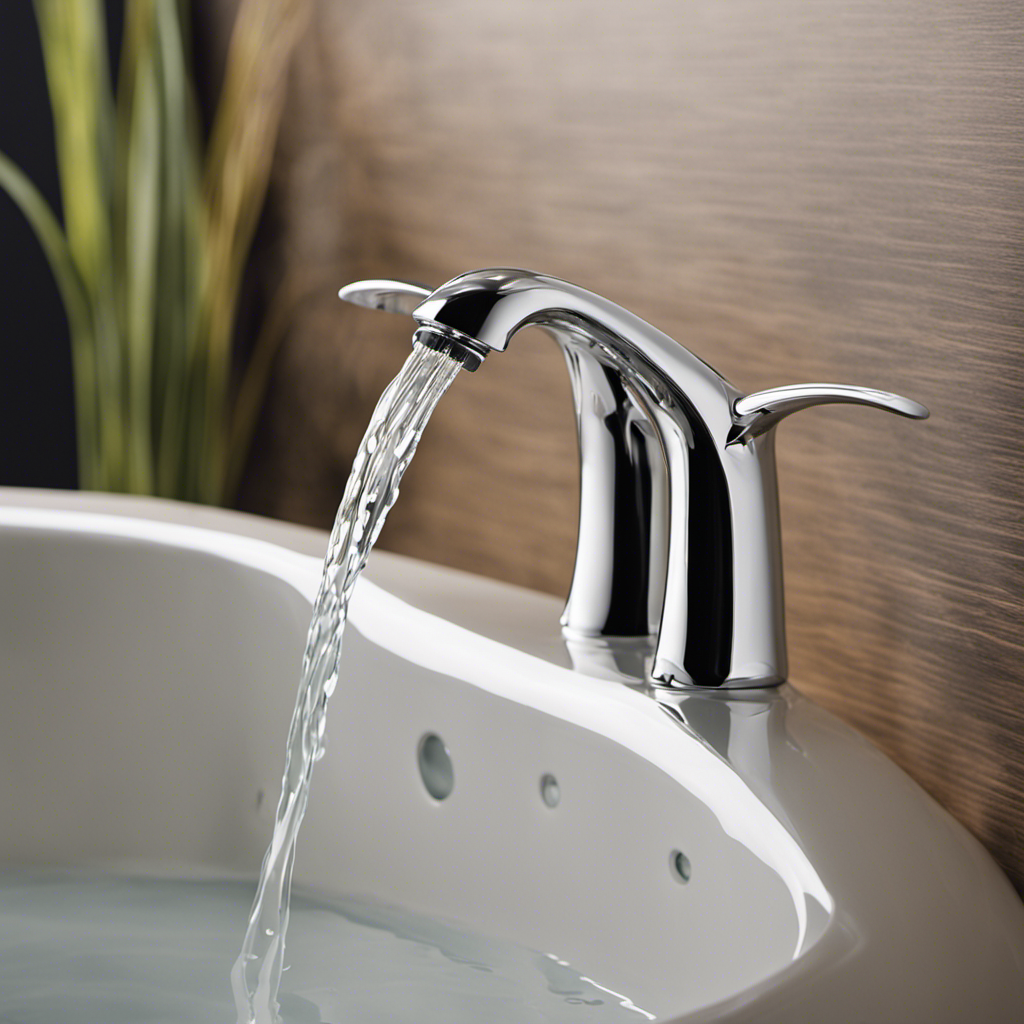Are you tired of scrubbing and battling with the grime in your bathtub? Well, fret no more! In this article, we’ve got the ultimate guide to help you reclaim your sparkling sanctuary.
We will walk you through the process of assessing the bathtub’s condition, gathering the necessary supplies, and preparing it for a deep clean.
Say goodbye to soap scum, tough stains, and hard water deposits. Get ready to indulge in the satisfaction of a squeaky clean bathtub!
Key Takeaways
- Assess and repair any visible damage before cleaning the bathtub
- Gather essential cleaning supplies and tools, including bathroom cleaner, disinfectant, and scrub brush
- Take necessary safety precautions, such as wearing gloves and goggles, and ensuring proper ventilation
- Use specific cleaning techniques for different areas, such as removing stains and rust, cleaning the drain and overflow, scrubbing the bathtub surface, and addressing hard water deposits
Assessing the Bathtub’s Condition
Before you start cleaning, make sure you assess the bathtub’s condition. Evaluating the damage is crucial in determining the appropriate cleaning method for your bathtub.
Take a close look at the surface of the tub and check for any visible signs of wear and tear, such as chips, cracks, or discoloration. If you notice any damage, it’s important to address it before proceeding with the cleaning process.
Small chips or cracks can be repaired using a bathtub repair kit, while larger damages may require professional assistance. Additionally, consider the material your bathtub is made of, as different materials may require specific cleaning methods.
Gathering the Necessary Cleaning Supplies
When it comes to cleaning your bathtub, there are a few key points to consider.
First, you’ll need to gather the essential cleaning products, such as a bathroom cleaner, disinfectant, and scrub brush.
In addition, having the right tools for scrubbing, such as a sponge or bristle brush, will make the task easier and more effective.
Lastly, don’t forget about the safety precautions needed, such as wearing gloves and ensuring proper ventilation in the bathroom.
Essential Cleaning Products
To clean your bathtub, you’ll need a few essential cleaning products. When assessing product effectiveness, it’s important to choose eco-friendly options that are both effective and safe for the environment. Here are some essential cleaning products that can help you achieve a sparkling clean bathtub:
| Product | Purpose |
|---|---|
| Bathroom cleaner | Removes soap scum and stains |
| White vinegar | Removes hard water stains |
| Baking soda | Acts as a natural scrubbing agent |
| Microfiber cloth | Helps to scrub and polish |
| Scrub brush | Ideal for tough stains |
| Rubber gloves | Protects your hands from harsh chemicals |
Tools for Scrubbing
Let’s start by discussing the tools you’ll need for scrubbing. When it comes to cleaning your bathtub, you have two main options: a sponge or a brush. A sponge is great for general cleaning and can easily reach into corners and crevices.
On the other hand, a brush is ideal for tackling tough stains and grime. It provides more scrubbing power and can effectively remove stubborn dirt. Whichever tool you choose, make sure it’s in good condition and suitable for your bathtub’s material.
Additionally, using natural cleaning solutions can be a healthier and more environmentally friendly alternative. Ingredients like vinegar, baking soda, and lemon juice can effectively clean your bathtub without harsh chemicals.
Now that you know the tools you’ll need, let’s move on to the safety precautions needed.
Safety Precautions Needed
Ensure you have the necessary safety equipment, such as gloves and goggles, before starting your scrubbing project. It is important to take precautions to prevent accidents and protect yourself while cleaning the bathtub. Here is a table outlining the protective gear needed for a safe cleaning experience:
| Protective Gear | Purpose |
|---|---|
| Gloves | Protect your hands from harsh chemicals and potential cuts |
| Goggles | Prevent chemicals or debris from getting into your eyes |
Preparing the Bathtub for Cleaning
Start by removing any items or products from the bathtub before you begin cleaning. Once the bathtub is clear, the first step is to assess the bathtub’s material. This is important because different materials require different cleaning methods. Here’s how to do it:
-
Assessing the bathtub’s material:
-
Porcelain or enamel: These bathtubs are durable and can handle most cleaning products. However, avoid using abrasive cleaners that can scratch the surface.
-
Acrylic or fiberglass: These bathtubs are more delicate and require gentler cleaning methods. Use non-abrasive cleaners and avoid harsh chemicals that can damage the material.
-
Choosing the right cleaning method:
-
For porcelain or enamel bathtubs, use a mixture of baking soda and vinegar or a mild detergent.
-
For acrylic or fiberglass bathtubs, use a gentle cleanser specifically designed for these materials.
Removing Soap Scum and Grime
When it comes to removing soap scum and grime from your bathtub, there are a few key points to keep in mind.
First, using effective cleaning products is essential for achieving the best results.
Second, mastering proper scrubbing techniques can make a significant difference in tackling tough buildup.
Lastly, taking preventive measures can help to minimize future soap scum and grime, saving you time and effort in the long run.
Effective Cleaning Products
To effectively clean the bathtub, you’ll need some strong cleaning products. Here are a few options to consider:
-
Commercial cleaning products:
-
Look for products specifically designed for tackling tough bathroom grime and soap scum.
-
Choose products that contain powerful ingredients like bleach or ammonia for a deep clean.
-
Eco-friendly cleaning products:
-
Opt for natural cleaners that are safe for the environment and your health.
-
Look for eco-friendly brands that use plant-based ingredients and avoid harsh chemicals.
Remember, when using any cleaning product, it’s important to follow the instructions and take safety precautions. Always wear gloves and ensure proper ventilation in the bathroom.
Scrubbing Techniques
Now that you’ve chosen the right cleaning product for your bathtub, let’s talk about the proper scrubbing technique.
The first step is to select the right sponge for the job. Look for a sponge with a non-abrasive surface that won’t scratch your bathtub’s surface. A sponge with a textured side can be helpful for tackling tough stains.
To start scrubbing, wet the sponge and apply the cleaning product evenly on the surface of the bathtub. Use gentle yet firm pressure to scrub in circular motions, focusing on areas with soap scum, grime, or stains. Remember to clean all the nooks and crannies, including the corners and around the drain. Rinse the sponge frequently to remove dirt and debris.
Once you have scrubbed the entire surface, rinse the bathtub thoroughly with warm water to remove any residue. Finally, dry the bathtub with a clean towel to prevent water spots and streaks.
Preventing Future Buildup
One way you can prevent future buildup is by regularly wiping down the surfaces in your bathroom. This simple step can go a long way in maintaining the cleanliness of your bathtub.
Here are some additional tips to help you with long term maintenance:
-
Use a squeegee: After each use, quickly wipe down the bathtub with a squeegee to remove any excess water and prevent mineral deposits from forming.
-
Invest in a shower filter: Installing a shower filter can help remove impurities from your water, reducing the amount of residue that accumulates on your bathtub.
-
Clean the filter regularly: Be sure to clean or replace the filter as recommended by the manufacturer to maintain its effectiveness.
Tackling Tough Stains and Rust
You can easily remove tough stains and rust from your bathtub using a mixture of vinegar and baking soda.
To tackle rust stains, start by sprinkling baking soda directly onto the stains. Then, pour vinegar over the baking soda and let it fizz for a few minutes. Scrub the stains with a sponge or brush and rinse with water.
For tough soap scum, make a paste by mixing equal parts vinegar and baking soda. Apply the paste to the affected areas and let it sit for about 15 minutes. Scrub the scum away and rinse thoroughly.
Now that your bathtub is free from stains and rust, it’s time to move on to cleaning the drain and overflow to ensure a completely fresh and clean bathing experience.
Cleaning the Drain and Overflow
To keep the drain and overflow in good condition, make sure to regularly pour a mixture of vinegar and baking soda down the drain and let it sit for a few minutes before rinsing with hot water. This simple solution will help prevent clogs and keep your bathtub flowing smoothly.
In addition to this regular maintenance, it’s also important to clean the bathtub filter and unclog the drain when needed. Here are some steps to follow:
-
Cleaning the Bathtub Filter:
-
Remove the filter from the drain.
-
Rinse it under running water to remove any debris.
-
Scrub the filter gently with a brush to remove stubborn dirt.
-
Rinse again and reinstall the filter.
-
Unclogging the Drain:
-
Use a plunger to create suction and dislodge the clog.
-
If the plunger doesn’t work, try using a drain snake to remove the blockage.
Scrubbing the Bathtub Surface
Scrubbing the surface of the tub regularly will help maintain its cleanliness and prevent buildup. To effectively clean your bathtub, you’ll need the right cleaning tools and proper technique.
Start by gathering a non-abrasive sponge or cloth, a mild bathroom cleaner, and some water. Wet the surface of the tub and apply the cleaner, making sure to cover all areas. Use the sponge or cloth to scrub the surface in circular motions, focusing on any stains or areas with soap scum. Rinse the tub thoroughly with water to remove any residue.
By following this simple routine, you can keep your bathtub looking fresh and clean.
Now, let’s address the issue of hard water deposits and how to tackle them.
Addressing Hard Water Deposits
Now, let’s take a look at how you can deal with those stubborn hard water deposits. These mineral deposits can be a real pain, but with a few simple steps, you can prevent and remove them effectively.
Here’s what you can do:
-
Use vinegar: Mix equal parts white vinegar and water, then apply it to the affected areas. Let it sit for a few minutes before scrubbing away the deposits.
-
Try lemon juice: Squeeze fresh lemon juice onto the deposits and let it sit for a while. The citric acid will help break down the minerals, making them easier to remove.
By using these natural cleaning solutions, you can effectively tackle hard water deposits and keep your bathtub looking sparkling clean.
Now, let’s move on to the next section where we’ll learn how to clean faucets and fixtures.
Cleaning Faucets and Fixtures
To effectively address hard water stains on your faucets and fixtures, it’s important to understand how to remove them and prevent future buildup.
Removing hard water stains can be achieved using common household items such as vinegar or lemon juice. These acidic substances help break down the mineral deposits and make it easier to clean the stains off.
To prevent future buildup of hard water stains, consider installing a water softener or using a water filtration system. These devices help minimize the amount of minerals in your water, reducing the chances of stains forming on your faucets and fixtures.
Removing Hard Water Stains
First, you’ll want to gather some vinegar and a sponge to tackle those stubborn hard water stains in your bathtub. Here’s how you can remove those unsightly deposits and get your tub sparkling clean:
- Start by dampening the sponge with vinegar.
- Rub the vinegar-soaked sponge directly onto the hard water stains.
- Let the vinegar sit for a few minutes to break down the mineral buildup.
- Scrub the area with the sponge to remove the limescale deposits.
- Rinse the area thoroughly with water to remove any residue.
By following these steps, you can effectively remove hard water stains from your bathtub and restore its shine.
Now, let’s move on to the next section and learn how to prevent future buildup to keep your tub looking fresh and clean.
Preventing Future Buildup
Now that you’ve successfully removed hard water stains from your bathtub, it’s important to take steps to prevent future build-up and maintain a clean tub in the long term.
To prevent mineral deposits and stains from forming, consider using a water softener or installing a water filtration system to reduce the amount of minerals in your water.
Additionally, make it a habit to wipe down the bathtub after each use to remove any soap residue or water droplets that can contribute to build-up.
Regularly cleaning your bathtub with a mild cleaner or vinegar solution can also help prevent the formation of stains.
Lastly, be sure to address any plumbing issues promptly, as leaks or drips can lead to moisture buildup and mold growth.
Rinsing and Drying the Bathtub
After scrubbing the bathtub, you’ll want to rinse it thoroughly and then dry it with a clean towel. Here are some effective rinsing techniques and drying methods to ensure a sparkling clean bathtub:
-
Rinsing Techniques:
-
Start by using a detachable showerhead or a bucket of warm water to rinse off the soap and cleaning solution.
-
Pay extra attention to the corners and edges of the bathtub to remove any residue.
-
Drying Methods:
-
Use a clean, dry towel to wipe down the bathtub, ensuring that all moisture is removed.
-
For stubborn water spots or streaks, a microfiber cloth works wonders.
Maintaining a Clean Bathtub
To keep your tub looking fresh, it’s important to establish a regular cleaning routine. Maintaining cleanliness is key to ensuring your bathtub stays in good condition for a long time.
The best cleaning techniques involve using products specifically designed for removing soap scum, grime, and stains. Start by spraying the tub with a bathroom cleaner and allowing it to sit for a few minutes. Then, scrub the surface with a non-abrasive sponge or brush, paying attention to corners and hard-to-reach areas.
Rinse thoroughly with water and dry the tub using a clean cloth or towel. For stubborn stains, you can use a mixture of vinegar and baking soda. Remember to regularly remove any hair or debris from the drain to prevent clogs.
Frequently Asked Questions
How Often Should I Clean My Bathtub?
You should clean your bathtub regularly to maintain cleanliness and prevent buildup. Using natural cleaners has benefits such as being safer for your health and the environment. It typically takes about 20-30 minutes to clean a bathtub.
Can I Use Bleach to Clean My Bathtub?
Yes, you can use bleach to clean your bathtub, but there are also bleach alternatives and natural bathtub cleaners available. It’s important to follow the instructions and use caution when working with bleach.
What Is the Best Way to Remove Mold and Mildew From the Bathtub?
Want to remove mold and mildew from your bathtub? The best way is to use a combination of vinegar and baking soda. This method is effective and doesn’t require harsh chemicals.
How Can I Prevent Hard Water Stains From Forming in My Bathtub?
To prevent hard water stains in your bathtub, take preventive measures like installing a water softener or using a vinegar solution to clean regularly. These natural cleaning solutions can dissolve mineral deposits and keep your bathtub looking clean.
Is It Safe to Use Abrasive Cleaners on My Bathtub Surface?
Using abrasive cleaners on your bathtub surface can be unsafe and cause damage. Instead, consider alternative cleaning methods like using a mixture of baking soda and vinegar or a non-abrasive cleaner specifically formulated for bathtubs.
Conclusion
In conclusion, keeping your bathtub clean is essential for a hygienic and relaxing bathing experience. By following the steps outlined in this article, you can easily maintain a sparkling bathtub.
Did you know that according to a study conducted by the Centers for Disease Control and Prevention, an estimated 235,000 people over the age of 15 visit the emergency room each year due to injuries sustained in the bathroom? Regular cleaning can help prevent accidents and ensure a safe bathing environment for you and your family.
So, don’t wait any longer, grab your cleaning supplies and start scrubbing!










